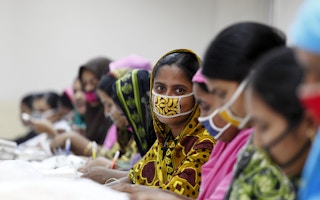The collapse of the Rana Plaza factory complex in Bangladesh in April 2013 shocked the world. More than 1,100 people died and 2,500 were injured by the sudden failure of a building with appalling safety standards that had developed major cracks the day before.
Revelations that many global clothing brands had been using the factory led to the Bangladesh Accord: a legally binding agreement between fashion companies, the Bangladeshi government and workers’ trade unions to make factories safe, publicly disclose inspection reports and educate workers about their rights. It meant that, for the first time, global brands agreed to monitor how the factories supplying their goods are run.
The move was also meant to push for transparency across the fashion supply chain. But, three years down the line, how much has changed? Very little, according to Bryony Moore, researcher at watchdog Ethical Consumer. And this means that another disaster like Rana Plaza is no less likely today than it was three years ago.
Moore is the joint author of a new transparency index that ranks fashion companies on how open they are about publishing details of their supply chains.
The research team — a collaboration between Ethical Consumer and campaigning organisation Fashion Revolution — selected 40 companies, a mix of luxury and high street brands. They sent them questionnaires asking about their supply chain monitoring policies and what information they make public.
If they failed to reply, the team gathered publicly available information from company websites. Then they scored them: the more transparent they are across different indicators, the higher their score.
“
The tech and the information is out there. It’s just a matter of bringing it together, but companies aren’t going to do that unless we tell them to.
Bryony Moore, Ethical Consumer
There has been some backlash to this methodology from luxury brands such as Chanel and Fendi, which fared particularly badly on the index. Chanel replied that the “reality of our actions seems more important to us than any related media coverage”.
But, as Moore tells me, this goes against the idea of transparency. Companies should be making clear how — and how far — they monitor supply chains, she explains. Transparency is essential, Moore says, to tackle the ‘don’t ask, don’t tell’ culture in the fashion industry.
So what did the index find? Even auditing the first supply tier — where clothes are sewn together and finished — is problematic, Moore says, because there is often so much subcontracting and sub-subcontracting, sometimes to homeworkers.
And beyond it, things get considerably worse. “When we started asking to drill down below sewing factories, companies didn’t seem to know,” Moore says. Only two of the surveyed companies published details of second-tier suppliers, which include fabric and yarn mills. And more than half published no details of monitoring processes for raw materials such as cotton.
This lack of transparency at yarn and raw material level could cover all manner of sins, from workers’ rights to pollution caused by dyeing. Cotton production can involve large-scale pesticide and water use, and human rights abuses such as the use of child labour. Production of the textile fibre rayon can cause deforestation.
“The global nature of the fashion industry means products move about,” Moore says. The labour and fabric behind just one T-shirt span continents. Companies could easily get this information, but they don’t seem to be doing so, she says.
For example, the technology used to buy and sell fabric or cotton could also help track transactions across supply chains, she says. “The tech and the information is out there. It’s just a matter of bringing it together, but companies aren’t going to do that unless we tell them to.”










